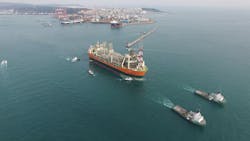bp assessing Shetland gas pipeline, emission cuts on Glen Lyon FPSO
Offshore staff
LONDON – bp and its partners plan to invest in a new 1.25-km gas pipeline at the Sullom Voe terminal on Shetland to bring more gas directly to the UK.
The company added that planning continues for a tieback of the Murlach discovery in the central UK North Sea to its offshore ETAP hub, while the Neptune-operated Seagull Field development should come onstream through the ETAP facilities in 2023.
About 175 km west of the Shetland Islands, the team at our giant Glen Lyon facility has done a huge amount of work to cut the FPSO vessel’s annual CO2e emissions by almost 100,000 tonnes.
On Glen Lyon, the FPSO serving the Quad204 development west of Shetland, the company has installed a flare gas recovery system that compresses and treats excess gas that would otherwise have been flared, and excess gas that previously would be vented from the cargo tanks.
The captured gas is then exported via a pipeline to Shetland before onward delivery into the UK gas network via the St Fergus terminal near Peterhead.
The process has eliminated routine gas flaring at the site, bp added.
The same team investigated how flaring could be minimized during a restart of operations following a shutdown, a process that typically results in excess flaring as the plant and reservoir are pressurized.
They found that the volume of gas sent to the flare could be lowered by shortening the time to start gas compression stages. On Glen Lyon, during normal operations up to three gas turbines have been used to generate heat and power, but the team is working on reducing the configuration to two turbines.
If trials are successful, up to 25,000 metric tons per year of carbon emissions could be saved.
Finally, bp is working with the Port of Leith north of Edinburgh on its development of Scotland’s largest offshore wind hub, assembling offshore wind turbine towers and blades for bp’s projects.
The company and partner EnBW have secured the area as a marshalling port for the Morven offshore wind project.
10.28.2022
